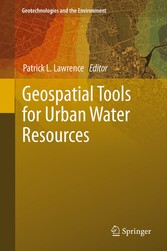Suchen und Finden
Geospatial Tools for Urban Water Resources
This book examines the application of geotechniques to address a wide range of issues facing urban water resources. Growing populations leading to urbanization and related development have lead to problems associated with water quality, storm water management, flood control, environmental health, and related ecosystem impacts. Major cities and other urban areas are facing challenges in addressing the implications of impacts to water resources. Recent innovations in geotechnologies, including Geographic Information Science (GIS), remote sensing, and other spatial tools and techniques, provide great opportunities and potential to assist in dealing with these problems. This volume provides a series of case studies that examine the application of new methods and approaches in a range of geotechnologies as utilized to better understand and resolve urban water resource concerns in communities throughout the world. Computer based mapping, spatial analysis, satellite imagery, decision support systems, web based applications, aerial photography, and other methods are highlighted by their development and application. The research presented in this volume will provide for an excellent source of knowledge and learning to assist professionals, experts, and students with a better understanding of how the use of geotechnologies can be used to assist urban communities to address water resource challenges.
Dr. Patrick L. Lawrence is an environmental geographer with interests in water resources, watershed planning, landscapes, land use change, natural area planning, the Great Lakes, and natural hazards. He has been involved in numerous research projects and studies including community decision-making for watershed planning, parks and protected areas, human responses to flooding and erosion hazards, bioregional planning efforts, the use of remote sensing and GIS technologies for land use planning and landscape studies. His studies have focused on the Great Lakes basin with work undertaken in both the United States and Canada and at the local, regional, and international scales. He has served in active or leadership roles with many professional and community organizations including the Association of American Geographers, The Coastal Society, Canadian Coastal Zone Association, and International Association for Great Lakes Research. He was a founding Board member for Partners for Clean Streams Inc., a non-profit water quality organization formed in the NW Ohio area and since 1999 has been actively involved with the Maumee Area of Concern and Remedial Action Plan. His work has been published in many leading journals and funded by agencies such as the National Science Foundation, the Joyce Foundation, U.S. Department of Agriculture, U.S. Environmental Protection Agency, and the Ohio Environmental Protection Agency.
Alle Preise verstehen sich inklusive der gesetzlichen MwSt.








